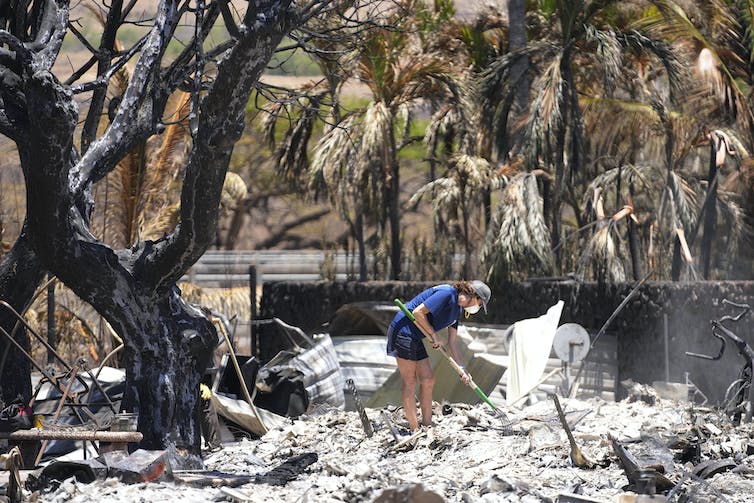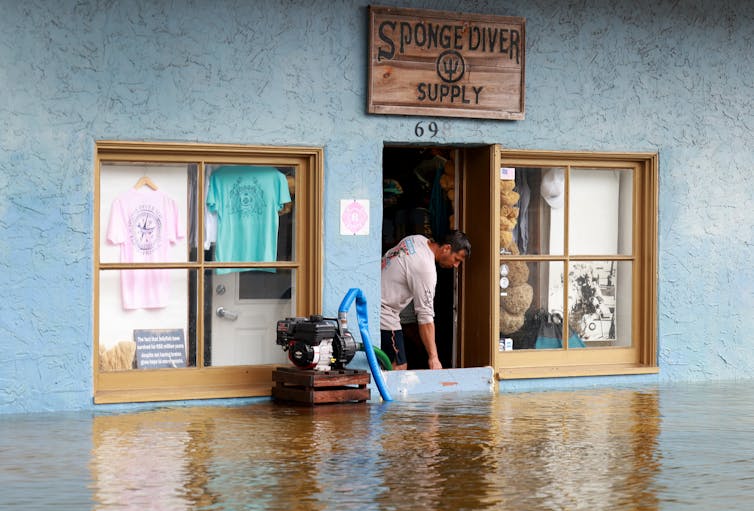How to get federal disaster aid: FEMA is running out of money, but these strategies can help survivors of Hurricane Idalia and the Maui fires get aid faster

As questions loom over the Federal Emergency Management Agency’s ability to fund disaster recovery efforts, people who lost homes to recent wildfires and storms are trying to make their way through the difficult process of securing financial aid.
Residents in communities hit by Hurricane Idalia, the Maui fires or other recent disasters have a long, tough journey ahead. How well the initial disaster response meets their needs has far-reaching consequences for community resilience, especially for vulnerable residents, as we saw after Hurricanes Katrina and Maria.
I am a law professor who focuses on disaster recovery and preparedness and has created several legal clinics to assist survivors. Here’s what anyone facing losses after a federally declared disaster needs to know.
Declaring a disaster
The road to recovery starts with state and federal governments identifying damages – both property damage and economic damage. These assessments will shape the scope of federal assistance and how resources are allocated for each community and survivor. The level of damage will determine whether the president approves a major disaster declaration or simply an emergency declaration.
FEMA created a survey tool, released in May 2023, to make these assessments more consistent. It is now used by officials to collect information about damage to residences, whether owners or renters live there, and the amount of insurance coverage, among other details. That information is then used to determine the extent of the disaster, its impact on infrastructure and the type of aid needed in the request for a federal disaster declaration.
Hawaii Gov. Josh Green (center) and FEMA Administrator Deanne Criswell (right) speak to reporters in Lahaina on Aug. 12, 2023, while surveying the wildfire damage there.
AP Photo/Rick Bowmer
Once the federal government issues an emergency or major disaster declaration, individuals can apply for disaster recovery funding.
Documenting the damage
Step 2 is determining individual damages.
Amid the grief and the rush to find temporary housing and rebuild lives, it can be hard to focus on meticulously documenting what was lost and dealing with insurance. But federal aid has relatively short deadlines – people have 30 days from the formal disaster declaration to apply for disaster unemployment assistance and 60 days for individual and household assistance, such as aid for housing, though that deadline is often extended.
As soon as possible, disaster survivors should take photos of the damage and record every affected area of their property. That includes capturing details of damage to structures, personal belongings, vehicles and any medical equipment. This documentation will help provide the evidence for insurance claims, requests for government assistance and potential tax savings.

Even when everything is gone, as many homeowners discovered in Maui after the fires, there are ways to document the losses.
AP Photo/Rick Bowmer
The Internal Revenue Service has a helpful guide for reconstructing records after catastrophic disasters that destroy everything. Government agencies can recover lost driving records, mortgage records, wills and vehicle sales records. Most of the costs for these searches can be waived after a disaster.
There are other sources, too. Title companies, property tax assessors and real estate brokers will have many documents related to a home’s value and possibly photos. Insurance policies typically list major assets. Credit card companies may have statements showing major purchases. Mobile phones, friends and social media accounts may have more photos of the property.
Keeping records such as repair invoices, receipts, leases, canceled checks and money orders can also help provide an overview of the losses. FEMA recently amended its policy to also allow affidavits to prove ownership of homes passed down through generations, known as heirship property.
Finding disaster aid
People generally have four options for aid: insurance coverage, FEMA benefits, community or nonprofit funding, and private funding, including loans. Navigating this complex landscape can be hard.
Start with your insurance – homeowners insurance, renters insurance and insurance for vehicles, as well as medical, dental and health. Disaster survivors must apply for their relevant insurance payouts before FEMA will pay benefits. President Joe Biden made an exception to this rule to offer a one-time $700 payment for Maui residents to assist with critical needs, including shelter and transportation.
In cases where insurance coverage is denied or the person doesn’t have insurance, FEMA can become a lifeline.
FEMA’s Individual Assistance program offers benefits that include coverage for temporary lodging, home repair, transportation and medical needs. The agency provides up to $41,000 for housing assistance after emergencies or disaster declarations. FEMA’s disaster relief fund is close to depleted, however, after several multibillion-dollar disasters. Without additional funding from Congress soon, FEMA Administrator Deanne Criswell said some recovery funding may be delayed to the next fiscal year, which starts in October.

A store owner uses a sump pump to try to keep Hurricane Idalia’s rain and storm surge from flooding the building in Tarpon Springs, Fla., on Aug. 30, 2023.
Joe Raedle/Getty Images
To cover the costs that go beyond FEMA’s limits, survivors may need to secure private loans or disaster loans, such as Small Business Administration disaster loans, to bridge the gap. Homeowners can apply for SBA loans to replace or repair their primary residence or personal property, including cars, furniture and other items. Additionally, SBA loans can also cover business losses.
For those unwilling or unable to resort to loans, state and local governments often create housing recovery centers using Community Development Block Grants. These grants can help survivors reestablish housing, but the funding also takes much longer to arrive. A CBDG grant in Baton Rouge provided funding for rebuilding housing and to mitigate future flood damage in housing and rental programs after the area flooded in 2016.
Community partnerships are crucial
Amid the complexities of disaster recovery, the importance of community planning and collaboration cannot be overstated.
A coordinated approach that involves local governments, relief organizations and community leaders serves as a catalyst for effective recovery and also makes it easier to identify vulnerable populations and ensure the equitable distribution of resources so no one is left behind.
Communities often set up centers where residents can find and speak to advisers from insurance companies, FEMA and other sources of support. These disaster recovery centers can be the cornerstone for long-term recovery groups that help a community both recover and build resilience.
Five years after Hurricane Maria, community groups were still on the ground in Puerto Rico providing aid and resources to the local community. Ten years after Hurricane Katrina, local housing groups were still providing support to New Orleans residents, especially those employed in the hospitality industry.
In the midst of this formidable journey to recovery, the indomitable spirit of communities banding together, combined with the concerted efforts of government agencies and organizations, can be uplifting. Each step forward represents a collective stride toward healing, renewal and a future marked by greater unity.






